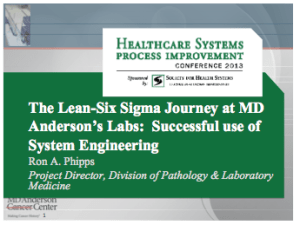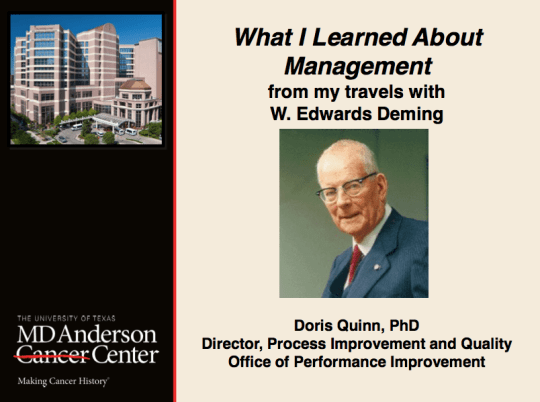I think this was my sixth consecutive year attending the annual Society for Health Systems Conference, held this year in New Orleans.
In the next few posts, I will share at least one key point from the talks and sessions I attended, with this post covering the first two – Doris Quinn, PhD and Ron Phipps, both from MD Anderson Center Center in Houston.
Doris Quinn, PhD – MD Anderson
Dr. Quinn, who is the leader of the Clinical Safety & Effectiveness Program at MD Anderson, gave a talk about her time working for Dr. W. Edwards Deming as an assistant and nurse from 1989 until his death in 1993. You can watch an online video of her giving this talk previously at MD Anderson.
She mentioned a phrase Deming used a lot, that we often work under “the tyranny of the prevailing style of management.”
- “The present style of management is the biggest producer of waste, causing huge losses whose magnitude cannot be evaluated, cannot be measured.”
Quinn described a time when Deming visited the Nashua Paper Company. Deming would first talk to front line workers, simply saying, “I'm a visitor. I want to learn.” Quinn said, “He was extremely interested in joy in work and how people were supported in doing their jobs.”
Deming would then meet with progressively higher levels of leadership throughout the day, being more challenging as he went up the chain. The problem was not the workers and he treated them accordingly.
Quinn reminded us of something Deming would say often – that the first place to start is understanding the AIM of a system. It's the “responsibility of leaders to determine the AIM and then manage the system.”
She talked about a “death spiral” (as dubbed in the systems dynamics field) where an east coast hospital (where her son works?) went through this cycle:
- Hospital profits are down, so leaders proclaim a hiring freeze
- There aren't enough phlebotomists to get the job done
- So, lab turnaround times are longer than they need to be
- The time to make medical decisions is longer because of the wait for lab test results
- The doctors are ready to discharge the patient, but have to wait on lab results
- The patient has to kept overnight again
- This decreases profits (because cost is higher and the reimbursement – revenue – is often fixed)
- Leaders react by wanting to reduce headcount and the cycle continues
Note: a “short staffing” situation can be addressed by reducing waste and improving processes, not just hiring more people. But, there are times when staffing levels are just grossly inadequate and adding more people is still necessary even when waste is reduced. There are times when spending a little bit of money (even as a short-term countermeasure) makes sense when we can save a lot of money as a result.
In that above scenario, imagine how it demoralizes the physicians to get a nasty email from “leadership” that says “PLEASE DISCHARGE YOUR PATIENTS!!!” as happened in the scenario Quinn described.
Ron Phipps – MD Anderson Pathology & Laboratory Medicine
 Ron, a quality project manager, started his presentation by giving credit to the others he worked with, emphasizing that what he was presenting was not done alone. The picture on his slide was great – “A turtle on a fencepost didn't get there by itself.”
Ron, a quality project manager, started his presentation by giving credit to the others he worked with, emphasizing that what he was presenting was not done alone. The picture on his slide was great – “A turtle on a fencepost didn't get there by itself.”
They started using Lean methods in their lab in 2004, getting help from my former employer, ValuMetrix Services. They were planning a $2 million automation system, but Ron had concerns they were going to be automating a bad process. So, they used Lean to redesign the workflow, meaning they could avoid the automation expense.
It's a great lesson and one I've seen a lot – Lean first, THEN automation. The same can be said for EMR or building a new facility… Lean (and process improvement) first, THEN build something.
They eventually did add automation in 2010 after volumes had increased 40% and the need was truly there.
Ron also focused on engaging employees in the 5S process – getting ideas from them and working together with them to make the changes they wanted, rather than forcing 5S practices on them in a top-down way. It's always great to hear about that because I think it's not really 5S and not really Lean if ideas are being forced on people.
More SHS posts to come…
What do you think? Please scroll down (or click) to post a comment. Or please share the post with your thoughts on LinkedIn – and follow me or connect with me there.
Did you like this post? Make sure you don't miss a post or podcast — Subscribe to get notified about posts via email daily or weekly.
Check out my latest book, The Mistakes That Make Us: Cultivating a Culture of Learning and Innovation:











I would add one strategy: the process of engaging employees through structured and consistent leadership rounding. Very powerful and effective.
[…] to other companies and other countries and try to copy, but they don’t know what to copy.” As Doris Quinn discussed, you can’t copy what you’ve seen when you have a weak foundation – hampered by […]